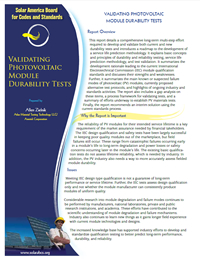
Validating PV Module Durability Tests
Download the one-page summary (PDF, 305KB) or the full report (PDF, 9.63MB).
Overview

This report details a comprehensive long-term multi-step effort required to develop and validate both current and new durability tests and introduces a roadmap to the development of a service life prediction methodology. It explains basic concepts and principles of durability and reliability testing, service life prediction methodology, and test validation. It summarizes the development rationale leading to the current International Electrotechnical Commission (IEC) module qualification standards and discusses their strengths and weaknesses. Further, it summarizes the main known or suspected failure modes of photovoltaic (PV) modules, currently proposed alternative test protocols, and highlights of ongoing industry and standards activities. The report also includes a gap analysis on these items, a process framework for validating tests, and a summary of efforts underway to establish PV materials tests. Finally, the report recommends an interim solution using the current standards process.
Why the Report is Important
The reliability of PV modules for their intended service lifetime is a key requirement of the market assurance needed by financial stakeholders. The IEC design qualification and safety tests have been largely successful in keeping poor quality modules out of the marketplace, but field failures still occur. These range from catastrophic failures occurring early in a module’s life to long-term degradation and power losses or safety concerns occurring later in the module’s life. The existing basic qualification tests do not assess lifetime reliability, which is needed by industry. In addition, the PV industry also needs a way to more accurately assess fielded module durability.
Key Findings
Although technically difficult, a methodology exists to develop a PV module life service prediction model. Developing this model would require extensive coordination, participation, and support from PV manufacturers, academia, research laboratories, testing facilities, and other stakeholders and may be slow to implement. However, many efforts currently underway could be more closely coordinated and aligned to support the key elements of this approach, yielding substantial improvements in life service prediction in the near term.
In the short term, an expedient approach is the development of a comparative module performance database as a tool. To be effective industry-wide, however, this needs to be expanded (even if on a voluntary basis). Standards that require module manufacturers to report actual data rather than using a generic pass/fail approach may assist with this approach. Some module manufacturers and buyers already advocate hard data reporting, and this may serve industry needs while a true service life prediction methodology is implemented. There may be variation in the data, but where the methodology applies stresses that are relevant to the use environment, use of these results may make possible statistical predictions regarding how long modules will last in a given location.
The practice of effectively using a test standard as the basis of a worldwide experiment could also be practical. This may be a way to accomplish “extensive coordination” without the huge budget required to have researchers execute a similar project. Moving studies out of carefully controlled test fields and turning the whole world into a data collection laboratory may be the way to best answer the question “How long will my module last?” and connect with the real needs of the customer.